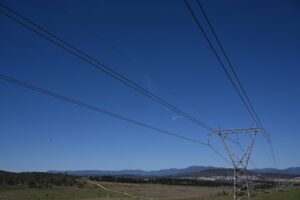While most energy analysts think carbon capture and storage (CCS) is on death row due to high costs, a dependence on public funding and dwindling new coal plant plans in many countries, the Minerals Council of Australia (MCA) have banged the CCS drum once more.
 Late last week they announced the formation of an “industry-led Leadership Roundtable for the development of Low Emissions Technologies for Fossil Fuels.” Take that, carbon dioxide!
Late last week they announced the formation of an “industry-led Leadership Roundtable for the development of Low Emissions Technologies for Fossil Fuels.” Take that, carbon dioxide!
The “roundtable” will be chaired by Stewart Butel, the managing director of Wesfarmers Resources – a sibling of retail giant Coles – and an unnamed director of the Minerals Council of Australia (MCA), the coal industry lobby group.
The MCA represents big coal exporters such as BHP Billiton, Rio Tinto, GlencoreXstrata and Peabody Energy, and Victorian brown coal generators such as GDFSuez, the owner of the polluting Hazelwood power station and associated mine. And there’s a handful of coal wannabes on the membership roll thrown in for good measure.
Who exactly is going to be involved with the MCA’s “roundtable” is rather vague, other than that it will include unnamed “senior representatives from the coal, oil and gas, and power generation industries, research organisations, federal and state governments and the Global CCS Institute.”
What it will do is even vaguer, though the intent is clearly to suggest that the ailing coal industry is showing willing on CCS.
The roundtable, the MCA proclaims, will “share information on relevant low emission technology activities across Australia and overseas and to identify potential new studies and activities that could address current gaps and future needs. These may include technologies for high efficiency/lower emission generation, fugitive emission abatement and CCS.” [emphasis added]
As with earlier efforts, the roundtable also has an inbuilt PR function to “promote wider understanding of the role and importance of large scale demonstration of low emissions technologies for fossil fuels and their benefits to society. “
The MCA’s announcement makes no mention of how much – if anything – the coal lobby will spend on its initiative, perhaps because the now cash-strapped industry is in a penny-pinching mood.
However, it seems clear the roundtable will not be urging coal, oil and gas companies to spend more on CCS research and demonstration. Instead, the MCA states that the roundtable will “be an important input into the development of relevant federal and state government policies.”
The carbon dioxide emissions from Australia’s coal – whether burnt here or overseas – it seems, have little to fear from the MCA’s roundtable.
Déjà vu?
We have been here before.
In 2003 – while John Howard was still Prime Minister but looking rather climate-worn – the Australian coal industry announced that it was establishing the Coal21 fund with a voluntary levy of 20 cents on each tonne of black coal exported. Funds were raised and spent on a handful of potential projects in the heady days of CCS-boosterism. But before long, financial reality kicked in and the industry turned its eyes to federal and state treasuries.
The fall of Howard meant that the coal industry was under significant pressure from a newly elected Rudd Labor government.
In 2008 the Australian Coal Association announced that it had formed a Carbon Capture and Storage Taskforce to deliver a suite of legislative and policy measures to ensure 10,000 gigawatt hours of CCS power would be delivered in Australia by 2020. To help manage the politics of policies designed to promote more coal use under a Labor government the coal lobby enlisted WWF, the Climate Institute and the CFMEU as members of the taskforce.
But perhaps more than anything else, the industry wanted CCS to be funded by bucketloads of cash from taxpayers or electricity consumers or both. The taskforce touted the need for tax incentives, generous federal funding, funds for CCS from auctioning carbon permits and even a feed-in tariff for power generated from new coal plants fitted with CCS.
Rudd delivered in spades. There was hundreds of millions for the establishment and operation of the Global Carbon Capture and Storage Institute which took to proselytising CCS around the world with gusto. There was also favourable legislation shunting most of the carbon liability from CCS storage onto the taxpayer. Billions more was earmarked for the funding of two to four coal plants of over 1000 megawatts each but fitted with CCS.
Despite the lavish funding, more projects went belly up than inched forwards. By 2009 one Labor government adviser confided to a journalist that “clean coal has become an invitation for ridicule.”
Nor did it want the increasingly hard-earned coal industry cash frittered away on projects which had little prospect of being commercial for one or more decades.
In late 2012 the coal industry quietly changed the purpose of the Coal21 fund to more explicitly include a PR function: promoting the use of coal in Australia and overseas.
Last roll of the CCS dice?
The latest announcement from the coal lobby is notable for both for its timidity and how it aims to once more co-opt government policy making to serve the coal industry’s interests. There are no targets, no timetables and no guarantees of industry funding. To match the conservative politics of the time, WWF, the Climate Institute and the CFMEU have been jettisoned too.
The lack of specifics reflects the real-world financial realities crippling CCS.
Without a high carbon price, CCS has no chance of being viable. Even if there was a high carbon price, end use energy efficiency and renewables would still beat CCS hands down.
While the costs of fitting CCS to new coal plants are high, the costs of retrofits to existing plants – let alone those long past their mid-life crisis – are prohibitive.
Nor are, in Australia at least, potential underground storage sites located near most existing plants.
On top of that are the political headaches that inevitably go with proposals for new coal plants. The prospects seem remote that the Climate Institute or any other group wedded to the CCS cause could persuade the burgeoning fossil fuel divestment movement or rebellious farmers that CCS – which would require more coal mining, water extraction, coal ash dams and pollution – is a sacrifice worth making when better power generation alternatives exist.
All up the MCA’s announcement of a CCS ‘roundtable’ it is just the latest iteration of the coal industry’s perennial CCS PR ploy: a vague plan to do something, anything, except reduce the amount of coal mined, burnt and exported.
It is no accident that the MCA have been the leading opponents of a carbon price and are intent on killing the Renewable Energy Target.
Earlier this year Treasurer Joe Hockey proclaimed that he wants to “discourage the leaners” and “reward the lifters.” In his first budget, Hockey cut funding for new CCS projects but left funding in place to honour past Labor-government commitments.
After suffering years of federal government budget cuts to CCS spending – by both Liberal and Labor governments – the coal lobby is determined to have one more shot at recasting CCS as a “lifter” instead of a “leaner”.
It will be a tough job. In its media release announcing the roundtable the MCA pointed to the commissioning last week of a CCS project at the lignite-fired Boundary Dam power station in Saskatchewan in Canada. Nor did SaskPower, the Canadian utility which built it, mention in its media release announcing the opening of the plant that the 110 megawatt unit cost C$1.4 billion (US$1.2 bn; A$1.43 bn), of which C$240 million came from the Canadian government. The Boundary Dam CCS units cost the best part of three times as much as a conventional coal plant.
By anyone’s standards that’s a big bill for a very small coal unit. With the compressed carbon dioxide being used to boost oil production at a nearby oil field, the touted climate mitigation benefits are smaller than the headline figure.
Even so, the World Coal Association – the coal industry’s global lobby group – was quick to use the commissioning of the Boundary Dam CCS unit to stake a claim for more public funding. “To reduce emissions govt support for CCS needs to be equal to govt support for renewables & other low carbon technologies,” Tweeted the lobby group.
The MCA’s roundtable proposal is just the Australian leg of the global coal industry’s plan to get taxpayers to fund what the industry largely refuses to do.
A roundtable – as lame as it seems – is the best idea that the MCA could come up with in the hope that no-one remembers the dismal results that came from their earlier feasting on taxpayer funds for CCS.
Bob Burton is a Contributing Editor of CoalSwarm and a Director of the Sunrise Project, a non-profit group promoting a shift away from fossil fuels. With Guy Pearse and David McKnight he co-authored Big Coal: Australia’s Dirtiest Habit. His Twitter feed is here.








